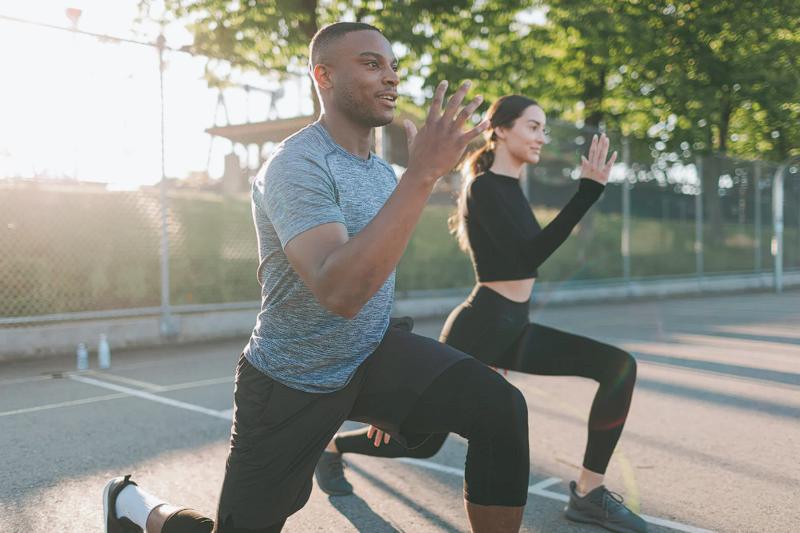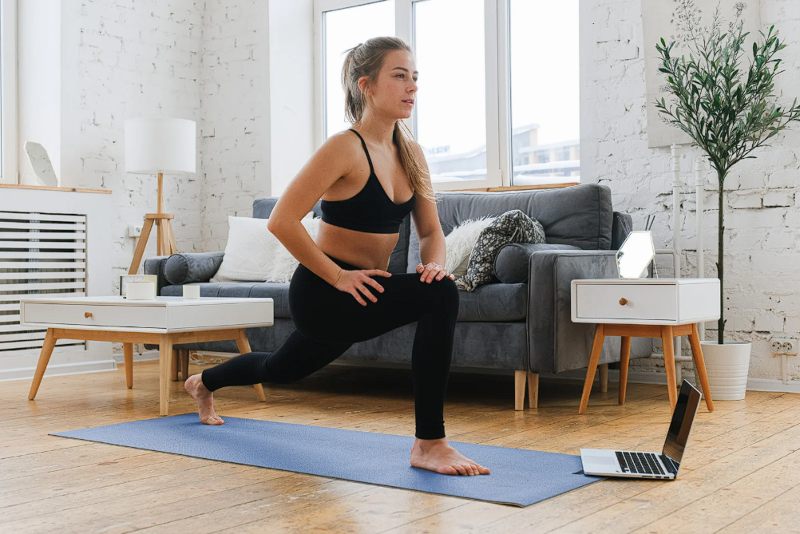17 Best Ways How Can You Optimize Your Physical Health

1. Introduction to Physical Health Optimization
How Can You Optimize Your Physical Health: Physical well-being serves as the fundamental basis for our overall health. It constitutes the state of our body’s systems, encompassing everything from cardiovascular fitness to muscular strength, flexibility, and mental resilience. To truly understand physical health, it’s essential to recognize that it’s not merely the absence of disease but rather a holistic equilibrium that allows our bodies to function optimally.
Table of Contents
Defining How Can You Optimize Your Physical Health
At its core, physical health is the state of harmony and functionality within our bodies. It’s the ability of our cardiovascular system to efficiently pump blood, our muscles to exert force and endure stress, our joints to move freely and without pain, and our organs to perform their respective functions without strain or obstruction. It’s not limited to the exterior appearance or fitness levels but extends deep into the cellular and molecular realms, where every metabolic process contributes to the overall state of well-being. [How Can You Optimize Your Physical Health]
Importance of Prioritizing Physical Health
The significance of prioritizing physical health cannot be overstated. In today’s fast-paced world, where demands on our time and energy are relentless, neglecting our physical well-being can have far-reaching consequences. Chronic diseases such as obesity, diabetes, hypertension, and heart disease are not just prevalent but are also leading causes of mortality worldwide. By prioritizing physical health, we mitigate the risk of falling prey to these ailments, thereby ensuring a longer, healthier life.
Moreover, physical health doesn’t operate in isolation; it’s intricately linked to our mental and emotional well-being. Regular exercise, balanced nutrition, and adequate rest not only strengthen our bodies but also bolster our mood, improve cognitive function, and reduce stress and anxiety. Thus, by investing in our physical health, we reap dividends that extend beyond the realm of physiology, enhancing our overall quality of life. [How Can You Optimize Your Physical Health]
Overview of the Article’s Content
In the pages that follow, we will embark on a comprehensive journey towards optimizing physical health. We’ll delve into 17 actionable strategies, each meticulously curated to provide maximum benefit with minimal effort. From exercise routines to dietary recommendations, sleep hygiene to stress management techniques, this article leaves no stone unturned in its quest to empower you to take charge of your physical well-being.
Our approach is grounded in scientific evidence, drawing upon the latest research and expert insights to guide you towards sustainable health outcomes. Whether you’re a seasoned fitness enthusiast or a novice embarking on your wellness journey, this article caters to individuals of all backgrounds and fitness levels. So, buckle up and prepare to embark on a transformative voyage towards a healthier, happier you. [How Can You Optimize Your Physical Health]
2. Understanding the Components of Physical Health
Physical health comprises several interrelated components, each playing a crucial role in maintaining overall well-being. By understanding these components and addressing them holistically, we can optimize our physical health and enhance our quality of life.

Exploring Physical Fitness
Physical fitness encompasses various aspects of bodily function, including cardiovascular endurance, muscular strength, flexibility, and body composition. Engaging in regular exercise routines that incorporate cardiovascular activities, strength training, and flexibility exercises is key to improving and maintaining physical fitness. Whether it’s jogging, weightlifting, yoga, or swimming, finding activities that you enjoy and that challenge your body in different ways is essential for overall fitness. [How Can You Optimize Your Physical Health]
Nutrition and Diet
Nutrition plays a central role in supporting physical health by providing essential nutrients needed for energy production, tissue repair, and overall bodily function. Maintaining optimal health requires a well-balanced diet abundant in fruits, vegetables, lean proteins, whole grains, and healthy fats. Paying attention to portion sizes, staying hydrated, and minimizing intake of processed foods, sugary beverages, and excessive amounts of salt and saturated fats can help maintain a healthy weight and reduce the risk of chronic diseases.
Sleep Quality
Ensuring high-quality sleep is vital for both physical health and overall well-being. During sleep, the body repairs tissues, consolidates memories, and regulates hormones involved in metabolism and stress response. Aim for 7-9 hours of uninterrupted sleep per night, and establish a regular sleep schedule to promote better sleep quality. Create a relaxing bedtime routine, optimize your sleep environment by keeping it dark, quiet, and cool, and limit screen time before bed to ensure restful sleep. [How Can You Optimize Your Physical Health]
Stress Management
Prolonged stress can negatively impact physical health, leading to issues like high blood pressure, heart disease, obesity, and weakened immune system. Developing effective stress management techniques is crucial for maintaining optimal health. Practice mindfulness meditation, deep breathing exercises, yoga, or progressive muscle relaxation to reduce stress levels. Additionally, engaging in hobbies, spending time with loved ones, and seeking professional support when needed can help alleviate stress and promote overall well-being.
By addressing these components of physical health—physical fitness, nutrition and diet, sleep quality, and stress management—we can cultivate a balanced and sustainable approach to health and wellness. [How Can You Optimize Your Physical Health]
3. Setting SMART Goals for Physical Health
Establishing SMART goals is a powerful strategy for optimizing physical health and achieving lasting improvements. By setting specific, measurable, achievable, relevant, and time-bound objectives, individuals can effectively track their progress and stay motivated on their health journey.
What are SMART Goals?
SMART goals are objectives that are:
- Specific: Clearly defined and focused on a particular outcome or behavior.
- Measurable: Quantifiable so that progress can be tracked and evaluated.
- Achievable: Realistic and attainable given the individual’s resources and circumstances.
- Relevant: Aligned with the individual’s values, priorities, and overall health objectives.
- Time-bound: Linked to a particular timeframe or deadline for achievement.
By adhering to these criteria, individuals can create goals that are clear, actionable, and conducive to success. [How Can You Optimize Your Physical Health]
Why SMART Goals are Important for Health Optimization
SMART goals provide structure and direction to the process of health improvement. They help individuals clarify their intentions, identify potential obstacles, and develop concrete action plans for success. Moreover, SMART goals promote accountability by establishing clear criteria for achievement and progress monitoring. This framework fosters a sense of empowerment and self-efficacy, motivating individuals to take proactive steps towards better health outcomes.
Examples of SMART Goals for Physical Health Improvement
1. Specific: “My goal is to engage in a 30-minute walk every morning prior to beginning my workday. “Measurable: “I will utilize a fitness tracking device to monitor my daily step count, aiming to reach a minimum of 10,000 steps each day.””Achievable: “I will start with shorter walks and gradually increase the duration as I build stamina.”Relevant: “Walking aligns with my goal of improving cardiovascular fitness and maintaining a healthy weight.”Time-bound: “I will achieve my target of walking 30 minutes daily within the next month.”
2. Specific: “I will meal prep healthy lunches for the workweek every Sunday.”Measurable: “I will prepare five balanced meals consisting of lean protein, whole grains, and vegetables.”Achievable: “I will research and select simple recipes that I can easily prepare within my available time and budget.”Relevant: “Meal prepping aligns with my goal of adopting a nutritious diet to support my overall health and fitness goals.”Time-bound: “I will start meal prepping this Sunday and continue each week thereafter.”
By setting SMART goals tailored to their individual needs and priorities, individuals can make tangible progress towards enhancing their physical health and well-being. [How Can You Optimize Your Physical Health]
Developing a Balanced Exercise Routine
Creating a well-rounded exercise regimen is essential for optimizing physical health and achieving fitness goals. By incorporating a variety of exercises that target different muscle groups and fitness components, individuals can enhance overall strength, endurance, flexibility, and cardiovascular health.
Types of Exercises: Aerobic, Strength Training, Flexibility
1. Aerobic Exercises: Aerobic or cardiovascular exercises elevate heart rate and increase oxygen consumption, improving cardiovascular fitness and endurance. Some examples are brisk walking, jogging, cycling, swimming, and dancing.
2. Strength Training: Strength training exercises focus on building muscle strength, size, and power. This includes exercises such as weightlifting, bodyweight exercises (e.g., push-ups, squats), resistance band workouts, and exercises using gym equipment like dumbbells and barbells.
3. Flexibility Exercises: Flexibility exercises enhance joint mobility, reduce muscle stiffness, and prevent injuries. These include stretching exercises, yoga, Pilates, and mobility drills aimed at improving range of motion and flexibility in various muscle groups. [How Can You Optimize Your Physical Health]
Creating a Personalized Exercise Plan
1. Assess Current Fitness Level: Begin by assessing your current fitness level, including strengths, weaknesses, and any health concerns or limitations.
2. Set Realistic Goals: Establish specific, achievable fitness goals based on your individual needs, preferences, and time constraints. Whether it’s improving cardiovascular endurance, increasing muscle strength, or enhancing flexibility, tailor your goals to align with your aspirations.
3. Choose Suitable Activities: Select activities that you enjoy and that suit your fitness level and preferences. Incorporate a mix of aerobic, strength training, and flexibility exercises to ensure a comprehensive workout routine.
4. Plan Frequency and Duration: Determine how often you will exercise each week and the duration of each session. Aim for a minimum of 150 minutes of moderate-intensity aerobic exercise or 75 minutes of vigorous-intensity aerobic exercise per week, along with at least two days of strength training exercises targeting major muscle groups.
5. Progress Gradually: Start slowly and gradually increase the intensity, duration, and frequency of your workouts as your fitness level improves. Listen to your body and adjust your exercise routine accordingly to prevent overtraining and injuries. [How Can You Optimize Your Physical Health]
Incorporating Variety into Workouts
Variety is key to preventing boredom, avoiding plateaus, and maximizing fitness gains. Incorporate different types of exercises, workout modalities, and training techniques to keep your workouts interesting and challenging. Experiment with new activities, classes, and outdoor pursuits to stay motivated and engaged.
Consider cross-training by alternating between different forms of exercise, such as cycling one day, strength training the next, and yoga or Pilates on another. Additionally, mix up the intensity, duration, and format of your workouts to keep your body guessing and adapt to new stimuli.
By developing a balanced exercise routine that includes aerobic, strength training, and flexibility exercises, tailored to your individual needs and preferences, you can achieve optimal physical health and fitness. [How Can You Optimize Your Physical Health]
5. Prioritizing Nutrient-Dense Foods
Focusing on nutrient-dense foods is fundamental for optimizing physical health and supporting overall well-being. By prioritizing foods rich in essential nutrients, individuals can fuel their bodies with the building blocks necessary for optimal function and vitality. [How Can You Optimize Your Physical Health]

Importance of a Balanced Diet
A balanced diet provides the body with the nutrients it needs to thrive, including vitamins, minerals, protein, carbohydrates, fats, and fiber. Consuming a variety of nutrient-dense foods from all food groups—such as fruits, vegetables, whole grains, lean proteins, and healthy fats—ensures that nutritional needs are met and supports overall health. [How Can You Optimize Your Physical Health]
Key Nutrients for Physical Health
1. Protein: Essential for muscle repair and growth, as well as supporting immune function and hormone production. Sources include lean meats, poultry, fish, eggs, dairy products, legumes, nuts, and seeds.
2. Fiber: Important for digestive health, promoting satiety, and regulating blood sugar levels. Found in fruits, vegetables, whole grains, legumes, nuts, and seeds.
3. Omega-3 Fatty Acids: Beneficial for heart health, cognitive function, and reducing inflammation. Sources include fatty fish (e.g., salmon, mackerel, sardines), flaxseeds, chia seeds, walnuts, and hemp seeds.
4. Calcium and Vitamin D: Vital for bone health and maintaining strong bones and teeth. Sources include dairy products, fortified plant-based milks, leafy green vegetables, and sunlight exposure for vitamin D synthesis.
5. Antioxidants: Protect cells from damage caused by free radicals, thereby reducing the risk of chronic diseases and supporting overall health. Found in colorful fruits and vegetables, berries, nuts, seeds, and herbs/spices. [How Can You Optimize Your Physical Health]
Planning and Preparing Healthy Meals
1. Meal Planning: Take time to plan balanced meals and snacks that incorporate a variety of nutrient-dense foods from different food groups. Strive for a vibrant plate featuring an assortment of fruits, vegetables, whole grains, lean proteins, and nutritious fats.
2. Grocery Shopping: Make a grocery list based on your meal plan and stick to it while shopping. Focus on purchasing fresh, whole foods and minimize processed and packaged items high in added sugars, sodium, and unhealthy fats.
3. Meal Preparation: Dedicate time each week to prepare and cook meals in advance, batch cooking items like grains, proteins, and vegetables to streamline mealtime. This can help save time during busy weekdays and ensure healthier eating choices.
4. Portion Control: Pay attention to portion sizes and avoid oversized servings, which can lead to overeating and weight gain. Employ smaller plates, bowls, and utensils to assist in managing portion sizes and avoiding excessive consumption.
By prioritizing nutrient-dense foods, including a variety of key nutrients in your diet, and planning and preparing healthy meals, you can nourish your body and support optimal physical health and well-being. [How Can You Optimize Your Physical Health]
6. Hydration: The Key to Wellness
Hydration plays a pivotal role in maintaining overall health and well-being, impacting various bodily functions and processes. Understanding the importance of hydration, recognizing signs of dehydration, and implementing strategies to stay hydrated throughout the day are essential for optimal health.

Understanding the Importance of Hydration
Proper hydration is crucial for the body’s functioning on multiple levels. Water is involved in various physiological processes, including regulating body temperature, lubricating joints, aiding digestion, transporting nutrients, and removing waste products. Maintaining adequate hydration supports cardiovascular health, cognitive function, skin health, and kidney function.
Hydration is especially vital during physical activity, as sweating leads to fluid loss and electrolyte depletion. Proper fluid intake helps replenish lost fluids and maintain electrolyte balance, preventing dehydration and promoting optimal exercise performance. [How Can You Optimize Your Physical Health]
Signs of Dehydration
Recognizing the signs of dehydration is essential for prompt intervention and prevention of health complications. Common symptoms of dehydration include:
1. Thirst: Thirst is the body’s primary signal of dehydration, indicating a need for fluid replenishment.
2. Dark Urine: Concentrated or dark-colored urine is a sign of dehydration. Ideally, urine should be pale yellow to clear in color.
3. Dry Mouth and Lips: Dryness of the mouth and lips can occur when the body lacks sufficient water.
4. Fatigue and Weakness: Fatigue and weakness may result from dehydration, leading to decreased physical and cognitive abilities.
5. Dizziness and Lightheadedness: Dehydration may cause dizziness, lightheadedness, and fainting due to decreased blood volume and reduced circulation.
6. Headache: Dehydration can trigger headaches and migraines due to changes in blood flow and electrolyte balance. [How Can You Optimize Your Physical Health]
Tips for Staying Hydrated Throughout the Day
1. Drink Water Regularly: Stay hydrated by drinking water regularly throughout the day, instead of waiting until you’re thirsty. Carry a reusable water bottle to serve as a reminder to maintain hydration levels.
2. Monitor Fluid Intake: Pay attention to your fluid intake and aim to consume at least 8-10 glasses of water per day, or more if you are physically active or in hot weather.
3. Incorporate Hydrating Foods: Consume foods with high water content, such as fruits (e.g., watermelon, oranges, strawberries), vegetables (e.g., cucumber, lettuce, celery), and soups.
4. Limit Dehydrating Beverages: Reduce consumption of dehydrating beverages such as caffeinated drinks, alcohol, and sugary beverages, which can increase fluid loss.
5. Set Hydration Reminders: Use phone alarms or hydration tracking apps to remind yourself to drink water regularly throughout the day.
6. Monitor Urine Color: Check the color of your urine regularly; pale yellow to clear urine indicates adequate hydration, while dark-colored urine may signal dehydration.
By understanding the importance of hydration, recognizing signs of dehydration, and implementing strategies to stay hydrated throughout the day, you can support your overall wellness and enhance bodily function. [How Can You Optimize Your Physical Health]
7. The Role of Sleep in Health Optimization
Sleep is a fundamental pillar of health, playing a crucial role in physical, mental, and emotional well-being. Understanding sleep cycles, recognizing the effects of poor sleep on physical health, and implementing strategies to improve sleep quality are essential for overall health optimization.

Understanding Sleep Cycles
Sleep occurs in cycles characterized by distinct stages, each serving specific functions essential for restorative and rejuvenating sleep:
1. Non-Rapid Eye Movement (NREM) Sleep: NREM sleep consists of three stages—N1, N2, and N3—that progressively deepen in intensity. During NREM sleep, the body repairs tissues, consolidates memories, and releases growth hormones.
2. Rapid Eye Movement (REM) Sleep: REM sleep is characterized by rapid eye movements, increased brain activity, and vivid dreaming. Rapid Eye Movement (REM) sleep is essential for cognitive function, emotional regulation, and the consolidation of memories.
The sleep cycle typically repeats multiple times throughout the night, with each cycle lasting approximately 90 minutes. [How Can You Optimize Your Physical Health]
Effects of Poor Sleep on Physical Health
Inadequate or poor-quality sleep can have profound effects on physical health, increasing the risk of various health conditions and compromising overall well-being:
1. Impaired Immune Function: Chronic sleep deprivation weakens the immune system, making individuals more susceptible to infections and illnesses.
2. Weight Gain and Obesity: Sleep deprivation disrupts hormonal balance, leading to increased appetite, cravings for high-calorie foods, and weight gain over time.
3. Cardiovascular Disease: Poor sleep is associated with hypertension, heart disease, and stroke due to its effects on blood pressure regulation and inflammation.
4. Metabolic Disorders: Sleep disturbances contribute to insulin resistance, glucose intolerance, and dysregulation of metabolic hormones, increasing the risk of type 2 diabetes and metabolic syndrome.
5. Reduced Physical Performance: Lack of sleep impairs physical performance, coordination, reaction time, and muscle recovery, hindering athletic performance and increasing the risk of injuries. [How Can You Optimize Your Physical Health]
Tips for Improving Sleep Quality
1. Establish a Consistent Sleep Schedule: Maintain a consistent bedtime and wake-up time every day, including weekends, to help regulate your body’s internal clock.
2. Create a Relaxing Bedtime Routine: Wind down before bed with calming activities such as reading, gentle stretching, or practicing relaxation techniques like deep breathing or meditation.
3. Optimize Your Sleep Environment: Create a comfortable sleep environment that is cool, dark, quiet, and free from distractions. Invest in a supportive mattress and pillows and use blackout curtains or eye masks to block out light.
4. Limit Exposure to Screens: Minimize exposure to screens (e.g., smartphones, computers, TVs) before bedtime, as the blue light emitted can disrupt melatonin production and interfere with sleep.
5. Limit Caffeine and Alcohol Intake: Avoid consuming caffeine and alcohol close to bedtime, as they can interfere with sleep quality and disrupt sleep cycles.
6. Exercise Regularly: Engage in regular physical activity, but avoid vigorous exercise close to bedtime, as it can stimulate the body and make it difficult to fall asleep.
7. Seek Professional Help if Needed: If you continue to experience persistent sleep difficulties despite trying self-help strategies, consult a healthcare professional for evaluation and guidance.
By understanding the importance of sleep, recognizing the effects of poor sleep on physical health, and implementing strategies to improve sleep quality, individuals can optimize their overall health and well-being. [How Can You Optimize Your Physical Health]
8. Managing Stress for Better Health
Effectively handling stress is crucial for preserving overall health and well-being. By understanding the impact of stress on the body, exploring stress management techniques such as meditation, deep breathing, and exercise, and incorporating relaxation into daily life, individuals can mitigate the negative effects of stress and improve their overall quality of life. [How Can You Optimize Your Physical Health]

Exploring the Impact of Stress on the Body
Stress is the body’s natural response to perceived threats or challenges, triggering a cascade of physiological and psychological changes aimed at preparing the body to deal with the situation. While acute stress can be beneficial in certain situations, chronic or prolonged stress can have detrimental effects on both physical and mental health:
1. Impact on the Nervous System: Chronic stress activates the sympathetic nervous system, leading to an increase in stress hormones such as cortisol and adrenaline. Prolonged activation of the stress response can disrupt the body’s hormonal balance, impair immune function, and contribute to the development of chronic diseases such as hypertension, heart disease, and diabetes.
2. Effects on Mental Health: Chronic stress is associated with an increased risk of anxiety, depression, and other mood disorders. Persistent feelings of stress and overwhelm can negatively impact cognitive function, memory, and concentration, affecting overall mental well-being.
3. Disruption of Sleep Patterns: Stress can disrupt sleep patterns, leading to difficulty falling asleep, frequent awakenings during the night, and overall poor sleep quality. Lack of restorative sleep further exacerbates stress levels, creating a vicious cycle of sleep disturbances and heightened stress. [How Can You Optimize Your Physical Health]
Stress Management Techniques: Meditation, Deep Breathing, Exercise
1. Meditation: Mindfulness meditation entails directing your focus to the present moment without passing judgment, aiding in stress reduction and relaxation. Regular meditation practice has been shown to lower cortisol levels, decrease anxiety, and improve overall emotional well-being.
2. Deep Breathing Exercises: Deep breathing techniques such as diaphragmatic breathing or belly breathing can help activate the body’s relaxation response, counteracting the physiological effects of stress. Deep breathing exercises promote relaxation, reduce muscle tension, and improve oxygenation of tissues.
3. Exercise: Physical activity is a potent stress reliever, stimulating the release of endorphins—natural mood-boosting chemicals in the brain. Engaging in regular exercise, whether it’s aerobic activities like walking, jogging, or cycling, or mind-body exercises like yoga or tai chi, can help reduce stress levels and improve overall resilience to stress. [How Can You Optimize Your Physical Health]
Incorporating Relaxation into Daily Life
1. Schedule Relaxation Time: Set aside dedicated time each day for relaxation and self-care activities. Whether it’s a few minutes of meditation, a leisurely walk outdoors, or indulging in a hobby you enjoy, prioritize relaxation as an integral part of your daily routine.
2. Practice Mindfulness: Cultivate mindfulness by bringing awareness to your thoughts, feelings, and sensations in the present moment. Mindfulness techniques can help you manage stress more effectively by fostering a sense of calm and acceptance in the face of challenging situations.
3. Establish Boundaries: Learn to say no to excessive commitments and prioritize activities that promote relaxation and well-being. Setting boundaries around work, social obligations, and personal time allows you to allocate resources effectively and prevent burnout.
4. Seek Support: Don’t hesitate to reach out to friends, family members, or a mental health professional for support during times of stress. Talking about your feelings and seeking assistance when needed can help alleviate stress and provide perspective on challenging situations.
By understanding the impact of stress on the body, exploring stress management techniques such as meditation, deep breathing, and exercise, and incorporating relaxation into daily life, individuals can cultivate resilience, reduce stress levels, and improve their overall health and well-being. [How Can You Optimize Your Physical Health]
9. Building Stronger Connections: Social Health
Cultivating meaningful social connections is integral to overall well-being, impacting both physical and mental health. Understanding how social connections influence physical health, implementing strategies for strengthening social bonds, and maintaining a balance between social interaction and personal time are essential components of fostering social health.

How Social Connections Impact Physical Health
1. Reduced Risk of Chronic Diseases: Strong social ties have been associated with a lower risk of chronic diseases such as cardiovascular disease, hypertension, and diabetes. Social support can buffer the effects of stress, reduce inflammation, and promote healthier lifestyle behaviors.
2. Enhanced Immune Function: Social connections play a role in supporting immune function and resilience. Studies have shown that individuals with strong social networks are better equipped to combat infections and recover from illness more quickly.
3. Longevity: Research indicates that people with robust social connections tend to live longer than those who are socially isolated. Strong social support systems provide emotional and practical assistance, fostering a sense of belonging and purpose that contributes to overall longevity. [How Can You Optimize Your Physical Health]
Strategies for Strengthening Social Bonds
1. Cultivate Meaningful Relationships: Invest time and effort in nurturing relationships with friends, family members, and community members. Make an effort to stay connected through regular communication, shared activities, and mutual support.
2. Participate in Social Activities: Engage in social activities and group events that align with your interests and values. Join clubs, classes, or volunteer organizations where you can meet like-minded individuals and build new connections.
3. Practice Active Listening: Show genuine interest in others by practicing active listening and empathetic communication. Be present in conversations, ask open-ended questions, and offer support and encouragement when needed.
4. Be Vulnerable and Authentic: Share your thoughts, feelings, and experiences openly with others, allowing for genuine connections to form based on authenticity and vulnerability.
Vulnerability fosters intimacy and trust in relationships, strengthening social bonds. [How Can You Optimize Your Physical Health]
Balancing Social Interaction with Personal Time
1. Set Boundaries: Establish boundaries around social interactions to ensure a healthy balance between social engagement and personal time for rest and rejuvenation. Learn to say no to social invitations when needed and prioritize self-care.
2. Schedule Alone Time: Carve out dedicated time for solitude and introspection to recharge and reflect. Use this time for activities that bring you joy and fulfillment, such as reading, journaling, or pursuing hobbies.
3. Practice Self-Compassion: Be kind to yourself and recognize the importance of self-care in maintaining overall well-being. Prioritize self-care activities that nourish your mind, body, and spirit, even amidst social engagements.
4. Monitor Social Media Use: Limit exposure to social media and digital communication platforms to prevent feelings of overwhelm and comparison. Use social media mindfully and selectively, focusing on quality interactions rather than quantity.
By understanding the impact of social connections on physical health, implementing strategies for strengthening social bonds, and maintaining a balance between social interaction and personal time, individuals can nurture their social health and cultivate fulfilling relationships that contribute to overall well-being. [How Can You Optimize Your Physical Health]
10. The Importance of Regular Health Screenings
Regular health screenings are essential for early detection, prevention, and management of various health conditions. Understanding the common health screenings recommended for different age groups, recognizing the role of preventive care, and implementing strategies for scheduling and keeping track of health check-ups are critical components of maintaining optimal health.

Common Health Screenings for Different Age Groups
1. Blood Pressure Screening: Regular blood pressure checks are recommended for adults of all ages to monitor cardiovascular health and detect hypertension, a leading risk factor for heart disease and stroke.
2. Cholesterol Test: Lipid profile testing is recommended for adults starting at age 20 to assess cholesterol levels and identify individuals at risk of heart disease and stroke.
3. Blood Glucose Test: Screening for diabetes or prediabetes is recommended for adults with risk factors such as obesity, family history of diabetes, or sedentary lifestyle.
4. Cancer Screenings: Different cancer screenings are advised depending on age, gender, and individual risk factors. Examples include mammograms for breast cancer, Pap smears for cervical cancer, colonoscopies for colorectal cancer, and prostate-specific antigen (PSA) tests for prostate cancer.
5. Bone Density Test: Bone density testing is recommended for postmenopausal women and older adults to assess bone health and screen for osteoporosis.
6. Vision and Hearing Tests: Regular vision and hearing screenings are important for maintaining sensory health and detecting age-related changes or conditions such as cataracts, glaucoma, and hearing loss. [How Can You Optimize Your Physical Health]
Understanding the Role of Preventive Care
Preventive care involves measures taken to prevent illness, detect diseases early, and promote overall health and well-being. Regular health screenings are a crucial component of preventive care, allowing healthcare providers to identify risk factors, diagnose conditions in their early stages, and intervene promptly to prevent complications.
Preventive care also includes lifestyle interventions such as vaccinations, healthy eating, regular physical activity, and smoking cessation, which help reduce the risk of chronic diseases and improve overall health outcomes. [How Can You Optimize Your Physical Health]
Scheduling and Keeping Track of Health Check-ups
1. Maintain a Health Calendar: Keep track of upcoming health screenings and appointments by maintaining a health calendar or using digital tools such as smartphone apps or online scheduling platforms.
2. Follow Recommended Guidelines: Familiarize yourself with the recommended guidelines for health screenings based on age, gender, and individual risk factors. Consult with your healthcare provider to determine the appropriate screening schedule for your needs.
3. Schedule Regular Check-ups: Schedule annual wellness exams with your primary care provider to discuss preventive health measures, review screening recommendations, and address any health concerns or symptoms.
4. Take Advantage of Preventive Services: Take advantage of preventive services covered by health insurance plans, including annual wellness visits, screenings, and vaccinations. Many insurers offer incentives or discounts for participating in preventive care programs.
5. Be Proactive: Advocate for your health by being proactive about scheduling and attending health screenings and check-ups. Take responsibility for your health by staying informed, asking questions, and actively participating in your healthcare decisions.
By prioritizing regular health screenings, understanding the role of preventive care, and implementing strategies for scheduling and keeping track of health check-ups, individuals can take proactive steps towards maintaining optimal health and preventing disease. [How Can You Optimize Your Physical Health]
11. Improving Posture and Ergonomics
Maintaining good posture and ergonomics is vital for overall physical health and well-being. Understanding the effects of poor posture on physical health, implementing tips for maintaining good posture, and incorporating ergonomic solutions into work and home environments are essential for promoting spinal health and reducing the risk of musculoskeletal issues.

Effects of Poor Posture on Physical Health
1. Musculoskeletal Strain: Poor posture places excessive stress on muscles, ligaments, and joints, leading to musculoskeletal strain, discomfort, and pain. Common areas affected by poor posture include the neck, shoulders, back, and hips.
2. Spinal Misalignment: Prolonged periods of slouching or hunching can contribute to spinal misalignment and imbalances, increasing the risk of conditions such as kyphosis (rounded upper back), lordosis (swayback), and scoliosis (sideways curvature of the spine).
3. Decreased Lung Capacity: Slouched posture compresses the chest cavity and restricts lung expansion, leading to shallow breathing and decreased oxygen intake. Over time, this can contribute to fatigue, reduced energy levels, and impaired respiratory function.
4. Digestive Issues: Poor posture can compress abdominal organs and interfere with digestion, leading to symptoms such as acid reflux, bloating, and constipation. Maintaining proper alignment can support optimal digestive function and alleviate discomfort. [How Can You Optimize Your Physical Health]
Tips for Maintaining Good Posture
1. Sit and Stand Tall: Maintain a neutral spine alignment by sitting and standing with your shoulders back, chest lifted, and chin parallel to the floor. Imagine a string pulling you gently upward from the top of your head to promote lengthening of the spine.
2. Support Your Back: Use ergonomic chairs with lumbar support to help maintain the natural curve of your lower back while sitting. If necessary, use a small cushion or rolled towel to provide additional lumbar support.
3. Adjust Your Workstation: Position your computer monitor at eye level to prevent neck strain and maintain a neutral neck position. Keep your keyboard and mouse close to your body and at elbow height to minimize reaching and strain on your shoulders and arms.
4. Take Frequent Breaks: Avoid prolonged sitting or standing in one position by taking regular breaks to stretch, walk, or change positions. Set reminders to stand up, stretch, and move around every hour during prolonged periods of sitting. [How Can You Optimize Your Physical Health]
Ergonomic Solutions for Work and Home Environments
1. Invest in Ergonomic Furniture: Choose ergonomic office chairs, desks, and accessories designed to promote proper posture and support spinal health. Look for adjustable features such as seat height, armrests, and lumbar support to customize your workstation.
2. Use Proper Lifting Techniques: When lifting heavy objects, bend your knees and keep your back straight to minimize strain on your spine. Lift with your legs rather than your back, and avoid twisting or jerking motions that can increase the risk of injury.
3. Create a Comfortable Sleep Environment: Choose a supportive mattress and pillow that maintain the natural curves of your spine while sleeping. Avoid sleeping on your stomach, which can strain your neck and back, and opt for side or back sleeping positions instead.
4. Practice Good Posture Habits: Incorporate postural exercises and stretches into your daily routine to strengthen core muscles and improve spinal alignment. Yoga, Pilates, and tai chi are excellent forms of exercise that promote flexibility, balance, and posture awareness.
By understanding the effects of poor posture on physical health, implementing tips for maintaining good posture, and incorporating ergonomic solutions into work and home environments, individuals can promote spinal health, decrease the likelihood of musculoskeletal problems and enhance overall well-being. [How Can You Optimize Your Physical Health]
12. Incorporating Mindfulness Practices
Integrating mindfulness practices into daily life can profoundly benefit physical health, mental well-being, and overall quality of life. Understanding the benefits of mindfulness for physical health, incorporating mindfulness into eating and exercise routines, and practicing simple mindfulness exercises for daily self-care are essential components of cultivating mindfulness and promoting holistic wellness.

Benefits of Mindfulness for Physical Health
1. Stress Reduction: Mindfulness practices such as meditation, deep breathing, and body scan exercises can help reduce stress hormones like cortisol and promote relaxation, leading to improvements in blood pressure, heart rate, and overall cardiovascular health.
2. Pain Management: Mindfulness-based techniques have been shown to alleviate chronic pain conditions by enhancing pain tolerance, reducing pain-related distress, and promoting acceptance of pain sensations without judgment.
3. Immune Function: Mindfulness practices may support immune function by reducing inflammation and strengthening immune responses. Regular mindfulness meditation has been associated with improvements in immune markers and decreased susceptibility to infections.
4. Sleep Quality: Mindfulness-based interventions can improve sleep quality by promoting relaxation, reducing bedtime rumination and anxiety, and enhancing overall sleep efficiency and duration. [How Can You Optimize Your Physical Health]
Mindful Eating and Exercise
1. Mindful Eating: Practice mindful eating by paying attention to the sensory experience of eating—savoring the flavors, textures, and aromas of food without distractions. Eat slowly, chew food thoroughly, and tune in to hunger and fullness cues to promote healthier eating habits and prevent overeating.
2. Mindful Exercise: Approach physical activity with mindfulness by focusing on the sensations of movement and the rhythm of your breath. Engage in activities that bring joy and fulfillment, whether it’s walking, yoga, dancing, or playing sports, and cultivate a sense of presence and appreciation for your body’s capabilities.
Simple Mindfulness Exercises for Daily Practice
1. Breath Awareness: Take a few moments to focus on your breath, observing the sensations of inhalation and exhalation without trying to change or control your breathing. Pay attention to the movement of your chest as you breathe or the feeling of air flowing in and out of your nostrils.
2. Body Scan: Perform a body scan exercise by bringing attention to each part of your body, starting from the top of your head and moving downward to your toes. Notice any areas of tension or discomfort, and gently release tension with each exhale.
3. Mindful Walking: Practice mindful walking by taking slow, deliberate steps and paying attention to the sensations of each foot making contact with the ground. Notice the rhythm of your steps, the movement of your body, and the sights and sounds around you as you walk.
4. Gratitude Practice: Cultivate gratitude by reflecting on three things you’re grateful for each day. Notice the positive aspects of your life, no matter how small, and express appreciation for the people, experiences, and blessings that enrich your life.
By incorporating mindfulness practices into daily life, individuals can reap the benefits of improved physical health, enhanced emotional well-being, and greater overall resilience to stress and adversity. With regular practice and commitment, mindfulness can become a powerful tool for promoting holistic wellness and living with greater presence and purpose. [How Can You Optimize Your Physical Health]
13. Finding Joy in Movement: Exercise as Play
Rediscovering the joy of physical activity and viewing exercise as play can transform workouts from mundane tasks into enjoyable experiences that promote both physical health and emotional well-being. Incorporating playful elements into workouts and engaging in recreational activities can reignite passion for movement and foster a lifelong commitment to staying active.

Rediscovering the Joy of Physical Activity
1. Reconnect with Childhood Play: Reflect on activities you enjoyed as a child, such as running, jumping, or playing sports, and consider how you can incorporate elements of those activities into your current fitness routine. Rediscovering the joy of movement can evoke feelings of nostalgia and excitement, making exercise more enjoyable and sustainable.
2. Explore New Activities: Step outside your comfort zone and explore new forms of physical activity that pique your interest. Whether it’s dancing, rock climbing, martial arts, or aerial yoga, trying new activities can challenge your body and mind in novel ways while keeping exercise fun and engaging.
3. Find Your Flow: Discover activities that induce a state of flow—a state of complete immersion and enjoyment in the present moment. Activities such as surfing, mountain biking, or trail running can facilitate flow experiences by providing a perfect balance of challenge and skill, leading to feelings of exhilaration and fulfillment. [How Can You Optimize Your Physical Health]
Incorporating Playful Elements into Workouts
1. Use Props and Equipment: Incorporate props and equipment such as stability balls, resistance bands, or agility cones into your workouts to add variety and make exercise more engaging. Experiment with different exercises and movement patterns to keep workouts fresh and exciting.
2. Play Fitness Games: Turn exercise into a game by setting fitness challenges, competing with friends or family members, or using gamified fitness apps and devices. Incorporate elements of competition, teamwork, or creativity to make workouts more playful and enjoyable.
3. Embrace Playful Movement: Embrace spontaneity and creativity in your workouts by engaging in playful movement activities such as animal walks, dance parties, or obstacle courses. Let go of rigid exercise routines and allow yourself to move freely and expressively. [How Can You Optimize Your Physical Health]
Engaging in Recreational Activities for Physical Health
1. Outdoor Adventures: Explore the great outdoors and engage in recreational activities such as hiking, kayaking, or stand-up paddleboarding. Outdoor adventures not only provide opportunities for physical exercise but also offer mental and emotional benefits such as stress reduction and connection with nature.
2. Team Sports: Join a recreational sports league or participate in pick-up games with friends to enjoy the camaraderie and social interaction that come with team sports. Playing team sports promotes physical fitness, teamwork, and sportsmanship while fostering a sense of belonging and community.
3. Dance and Movement Arts: Explore the expressive and artistic aspects of movement through activities such as dance, yoga, or tai chi. These practices not only improve flexibility, strength, and balance but also cultivate mindfulness, body awareness, and self-expression.
By finding joy in movement, viewing exercise as play, and incorporating playful elements into workouts and recreational activities, individuals can cultivate a positive relationship with physical activity and reap the numerous benefits for both body and mind. Embracing the playful spirit of movement can lead to greater motivation, satisfaction, and long-term adherence to a healthy and active lifestyle. [How Can You Optimize Your Physical Health]
14. Exploring Alternative Therapies
Alternative therapies offer holistic approaches to promoting physical health and well-being, complementing conventional medical treatments with practices rooted in ancient traditions and holistic philosophies. By understanding the overview of alternative therapies such as yoga, tai chi, and acupuncture, exploring their evidence-based benefits for physical health, and incorporating them into a holistic wellness plan, individuals can optimize their health and vitality through integrative approaches.

Overview of Alternative Therapies: Yoga, Tai Chi, Acupuncture
1. Yoga: Yoga is a mind-body practice that combines physical postures, breath control, and meditation to promote flexibility, strength, and relaxation. Various styles of yoga, such as Hatha, Vinyasa, and Kundalini, cater to different needs and preferences, offering a holistic approach to improving physical and mental well-being.
2. Tai Chi: Tai Chi, also known as Tai Chi Chuan, is a gentle form of martial arts characterized by slow, flowing movements and deep breathing. Originating from ancient Chinese tradition, Tai Chi promotes balance, coordination, and relaxation, making it suitable for individuals of all ages and fitness levels.
3. Acupuncture: Acupuncture is a traditional Chinese medicine practice that involves inserting thin needles into specific points on the body to stimulate energy flow and restore balance. Acupuncture is used to alleviate various physical ailments such as pain, inflammation, and digestive disorders, as well as to promote overall health and vitality. [How Can You Optimize Your Physical Health]
Evidence-Based Benefits for Physical Health
1. Yoga: Research has shown that regular yoga practice can improve flexibility, strength, and balance while reducing stress, anxiety, and depression. Yoga has been associated with numerous physical health benefits, including improved cardiovascular health, enhanced immune function, and better pain management for conditions such as lower back pain and arthritis.
2. Tai Chi: Studies have demonstrated that Tai Chi practice can improve balance, mobility, and functional ability in older adults, reducing the risk of falls and fall-related injuries. Tai Chi has also been shown to lower blood pressure, improve cardiovascular fitness, and enhance overall quality of life.
3. Acupuncture: Evidence suggests that acupuncture may be effective in relieving chronic pain conditions such as back pain, neck pain, and osteoarthritis. Acupuncture may also help alleviate symptoms of migraine headaches, reduce inflammation, and improve sleep quality and immune function. [How Can You Optimize Your Physical Health]
Incorporating Alternative Therapies into a Holistic Wellness Plan
1. Assess Individual Needs: Evaluate your unique health goals, preferences, and concerns to determine which alternative therapies may be most beneficial for you. Consider consulting with qualified practitioners or healthcare professionals for personalized recommendations.
2. Integrate Mind-Body Practices: Incorporate mind-body practices such as yoga, Tai Chi, or meditation into your daily routine to promote relaxation, stress reduction, and overall well-being. Start with small, manageable practices and gradually increase duration and intensity as you become more comfortable.
3. Combine Therapies for Synergy: Combine alternative therapies with conventional medical treatments and lifestyle interventions for a comprehensive approach to health and wellness. Utilize the strengths of each modality to address different aspects of physical and mental health, promoting synergy and holistic healing.
4. Stay Informed and Open-minded: Stay informed about emerging research and evidence supporting the efficacy of alternative therapies, but also approach new modalities with an open mind and discernment. Try out various methods and techniques to discover the ones that suit you best.
By exploring alternative therapies such as yoga, Tai Chi, and acupuncture, understanding their evidence-based benefits for physical health, and incorporating them into a holistic wellness plan, individuals can enhance their overall health and well-being through integrative approaches that address mind, body, and spirit. [How Can You Optimize Your Physical Health]
15. The Power of Positive Thinking
Positive thinking is a powerful mindset that can profoundly influence physical health, emotional well-being, and overall quality of life. By understanding the mind-body connection, cultivating optimism and resilience, and practicing techniques for positive self-talk and visualization, individuals can harness the transformative power of positive thinking to enhance their health and happiness.

Understanding the Mind-Body Connection
1. Impact on Physical Health: Research has shown that positive thinking can have a tangible impact on physical health outcomes, including reduced risk of chronic diseases, improved immune function, and faster recovery from illness and injury. Positive emotions such as joy, gratitude, and hope stimulate the release of endorphins and other neurotransmitters that promote well-being and enhance immune responses.
2. Influence on Emotional Well-being: Positive thinking contributes to emotional resilience and psychological well-being by fostering adaptive coping strategies, reducing stress levels, and promoting emotional regulation. Optimistic individuals are better equipped to handle life’s challenges, bounce back from setbacks, and maintain a positive outlook even in difficult circumstances. [How Can You Optimize Your Physical Health]
Cultivating Optimism and Resilience
1. Practice Gratitude: Cultivate an attitude of gratitude by focusing on the positive aspects of life and expressing appreciation for the blessings and opportunities that come your way. Keep a gratitude journal, write thank-you notes, or simply take a moment each day to reflect on the things you’re grateful for.
2. Challenge Negative Beliefs: Identify and challenge negative beliefs and thought patterns that undermine your sense of optimism and resilience. Replace self-defeating thoughts with more realistic and constructive interpretations, focusing on solutions rather than dwelling on problems.
3. Develop Problem-solving Skills: Enhance your ability to cope with challenges and setbacks by developing effective problem-solving skills. Break problems down into manageable steps, brainstorm potential solutions, and take proactive steps to address obstacles and achieve your goals. [How Can You Optimize Your Physical Health]
Techniques for Positive Self-Talk and Visualization
1. Affirmations: Use positive affirmations to reinforce beliefs and attitudes that support your well-being and success. Repeat affirmations such as “I am capable,” “I am resilient,” and “I attract positivity into my life” to cultivate a positive self-image and mindset.
2. Visualization: Practice visualization techniques to mentally rehearse positive outcomes and experiences. Shut your eyes and envision yourself accomplishing your goals, surmounting challenges, and living a life filled with joy and fulfillment. Visualize every detail vividly, engaging all your senses to create a powerful mental image of success.
3. Create a Vision Board: Create a visual representation of your goals, dreams, and aspirations by making a vision board. Gather images, quotes, and symbols that inspire and motivate you, and arrange them on a board or collage to create a tangible reminder of your vision for the future.
By harnessing the power of positive thinking through understanding the mind-body connection, cultivating optimism and resilience, and practicing techniques for positive self-talk and visualization, individuals can transform their lives and create a brighter, healthier, and more fulfilling future. [How Can You Optimize Your Physical Health]
16. Creating a Healthy Environment
The surroundings we inhabit play a significant role in shaping our physical health and overall well-being. By recognizing the importance of our environment on physical health, implementing tips for creating a healthy home and workspace, and incorporating nature into daily life, individuals can foster environments that support optimal health and vitality.

Importance of Surroundings on Physical Health
1. Impact on Air Quality: Indoor air quality can significantly impact respiratory health and overall well-being. Poor ventilation, indoor pollutants, and allergens such as dust, mold, and pet dander can exacerbate respiratory conditions and contribute to allergies, asthma, and other respiratory issues.
2. Influence on Mental Health: Our physical environment can also affect mental and emotional well-being. Cluttered and disorganized spaces can contribute to stress, anxiety, and feelings of overwhelm, while clean, organized, and aesthetically pleasing environments can promote relaxation, focus, and a sense of calm.
3. Connection to Nature: Spending time in natural environments has been shown to have numerous benefits for physical and mental health, including reduced stress levels, improved mood, enhanced immune function, and increased physical activity. Access to green spaces and natural elements such as sunlight, fresh air, and plants can promote overall well-being and quality of life. [How Can You Optimize Your Physical Health]
Tips for Creating a Healthy Home and Workspace
1. Maintain Cleanliness: Keep your home and workspace clean and clutter-free to minimize exposure to indoor pollutants and allergens. Regularly dust, vacuum, and air out rooms to improve air quality and create a healthier indoor environment.
2. Promote Natural Light: Maximize natural light exposure by opening curtains and blinds during the day and positioning workspaces near windows whenever possible. Natural light not only enhances mood and productivity but also regulates circadian rhythms and promotes better sleep quality.
3. Choose Non-Toxic Materials: Opt for non-toxic and eco-friendly materials when furnishing and decorating your home and workspace. Avoid products containing harmful chemicals such as volatile organic compounds (VOCs), formaldehyde, and phthalates, and opt for natural, sustainable alternatives whenever possible. [How Can You Optimize Your Physical Health]
Incorporating Nature into Daily Life
1. Spending Time Outdoors: Make time to spend outdoors and connect with nature on a regular basis. Take walks in parks, gardens, or nature reserves, go hiking or camping, or simply sit outside and enjoy the sights and sounds of the natural world.
2. Bring Nature Indoors: Incorporate natural elements such as houseplants, natural textures, and earthy colors into your indoor spaces to create a calming and rejuvenating environment. Indoor plants not only purify the air but also add beauty and vitality to interior spaces.
3. Practice Nature-based Activities: Engage in nature-based activities such as gardening, birdwatching, or nature photography to foster a deeper connection with the natural world and promote mindfulness, relaxation, and stress relief.
By recognizing the importance of our environment on physical health, implementing tips for creating a healthy home and workspace, and incorporating nature into daily life, individuals can cultivate environments that support optimal health, well-being, and quality of life.
17. Tracking Progress and Celebrating Success
Monitoring progress and acknowledging achievements are essential aspects of maintaining motivation and momentum on the journey toward optimal physical health and well-being. By understanding the importance of tracking health metrics, celebrating milestones and achievements, and adjusting goals and plans as needed, individuals can stay accountable, motivated, and committed to their health goals. [How Can You Optimize Your Physical Health]

Importance of Tracking Health Metrics
1. Visibility of Progress: Tracking health metrics provides visibility into one’s progress toward specific health goals and objectives. Whether it’s monitoring weight, body measurements, fitness levels, or other health indicators, tracking allows individuals to assess their current status and identify areas for improvement.
2. Accountability and Motivation: Regular tracking fosters accountability and motivation by holding individuals accountable for their actions and behaviors related to health and well-being. Seeing tangible evidence of progress can boost confidence, motivation, and adherence to healthy habits and lifestyle changes.
3. Identification of Trends and Patterns: Tracking health metrics over time enables individuals to identify trends, patterns, and correlations between lifestyle factors and health outcomes. This information can help inform decision-making, identify areas of improvement, and make adjustments to goals and strategies as needed. [How Can You Optimize Your Physical Health]
Celebrating Milestones and Achievements
1. Acknowledge Small Wins: Celebrate small victories and achievements along the way, whether it’s reaching a fitness milestone, sticking to a healthy eating plan, or making positive lifestyle changes. Acknowledging small wins reinforces progress, boosts morale, and fosters a sense of accomplishment.
2. Set Meaningful Milestones: Establish meaningful milestones and benchmarks to work toward, such as achieving a target weight, completing a fitness challenge, or improving specific health markers. Break larger goals into smaller, manageable milestones to maintain motivation and momentum.
3. Reward Yourself: Reward yourself for reaching milestones and achieving goals with meaningful rewards that align with your values and priorities. Whether it’s treating yourself to a spa day, indulging in a favorite hobby, or enjoying quality time with loved ones, rewards can serve as positive reinforcement for progress and success. [How Can You Optimize Your Physical Health]
Adjusting Goals and Plans as Needed
1. Regular Review and Assessment: Regularly review and assess your progress toward health goals and objectives to identify what’s working well and what may need adjustment. Reflect on challenges, setbacks, and successes, and use this feedback to refine your goals and plans as needed.
2. Flexibility and Adaptability: Remain flexible and adaptable in your approach to health and well-being, recognizing that circumstances and priorities may change over time. Be willing to adjust goals, strategies, and timelines to accommodate life’s challenges and opportunities while staying focused on long-term success.
3. Seek Support and Guidance: Seek support from healthcare professionals, coaches, or mentors who can provide guidance, accountability, and encouragement on your health journey. Collaborate with experts to develop realistic goals, create personalized plans, and navigate obstacles along the way.
By tracking progress and celebrating success, individuals can stay motivated and committed to their health goals while fostering a positive mindset and sense of achievement. With regular monitoring, acknowledgment of achievements, and flexibility in goal-setting, individuals can maintain momentum and progress toward optimal physical health and well-being. [How Can You Optimize Your Physical Health]
Conclusion
As we conclude our journey through the exploration of physical health optimization, it’s essential to reflect on the key strategies discussed and the importance of taking proactive steps to enhance our well-being. From understanding the components of physical health to cultivating a positive mindset and creating a supportive environment, every aspect contributes to our overall health and vitality.
Recap of Key Strategies for Physical Health Optimization
Throughout this article, we have delved into various strategies for optimizing physical health:
Understanding Physical Health Components: We explored the fundamental components of physical health, including fitness, nutrition, sleep quality, stress management, and the mind-body connection.
Setting SMART Goals: By setting specific, measurable, achievable, relevant, and time-bound goals, individuals can create a roadmap for health improvement and track their progress effectively. [How Can You Optimize Your Physical Health]
1. Balanced Exercise Routine: Incorporating aerobic exercise, strength training, and flexibility exercises into a personalized exercise plan promotes overall fitness and prevents injury.
2. Nutrient-Dense Diet: Prioritizing nutrient-dense foods and practicing portion control contribute to optimal nutrition and support overall health and well-being.
3. Hydration and Sleep: Staying hydrated and prioritizing quality sleep are essential pillars of physical health, contributing to energy levels, cognitive function, and overall vitality.
4. Stress Management: Implementing stress management techniques such as mindfulness meditation, deep breathing, and physical activity helps reduce the harmful effects of stress on the body and mind.
5. Social Connections and Preventive Care: Building strong social connections and scheduling regular health screenings are vital for promoting physical health and preventing illness and disease.
Encouragement for Readers to Take Action
As we conclude, I encourage each reader to take proactive steps toward optimizing their physical health. Start by assessing your current health status, identifying areas for improvement, and setting realistic goals that align with your values and priorities. Implement the strategies discussed in this article gradually, making small changes over time to establish sustainable habits.
Remember that progress takes time, patience, and dedication. Celebrate your successes along the way, no matter how small, and remain resilient in the face of challenges. Seek support from healthcare professionals, friends, and family members as needed, and don’t hesitate to adjust your goals and plans as you progress on your health journey. [How Can You Optimize Your Physical Health]
Commitment to Continued Health Improvement
Finally, I encourage each reader to commit to the ongoing pursuit of health improvement. Health is a lifelong journey, and there is always room for growth and refinement. Stay curious, stay informed, and remain open to new ideas and approaches that can further enhance your physical well-being.
Together, let us embrace the opportunity to prioritize our health, nurture our bodies, and live life to the fullest. By investing in our physical health today, we lay the foundation for a vibrant and fulfilling future.
Here’s to your continued health and vitality!
Frequently Asked Questions (FAQs)
Q1. What are the basic principles of physical health optimization?
The basic principles include regular exercise, balanced nutrition, quality sleep, stress management, and preventive healthcare.
Q2. What are some simple dietary changes I can make for better health?
Increase intake of fruits, vegetables, whole grains, lean proteins, and healthy fats while reducing processed foods, sugary drinks, and excessive salt and sugar intake.
Q3. How does stress impact physical health, and what are effective stress management techniques?
Stress can contribute to various health issues like high blood pressure, weakened immune system, and digestive problems. Effective stress management techniques include mindfulness meditation, deep breathing exercises, regular physical activity, and seeking support from friends and family.
Q4. Is it necessary to consult a healthcare professional before starting a new exercise or diet plan?
It’s advisable to consult a healthcare professional, especially if you have any underlying health conditions or concerns, to ensure that the plan is safe and suitable for your individual needs.
Q5. What are some signs that indicate I need to prioritize my physical health more?
Signs include persistent fatigue, unexplained weight changes, chronic pain, frequent illness, and difficulty performing daily tasks.
Q6. Can mindfulness and meditation really improve physical health?
Yes, mindfulness and meditation have been shown to reduce stress, improve sleep quality, lower blood pressure, and boost immune function, all of which contribute to better physical health.
Q7. How can I stay motivated to prioritize my physical health in the long term?
Set realistic goals, find activities you enjoy, track your progress, seek social support, and remind yourself of the benefits of prioritizing your physical health for long-term motivation.






